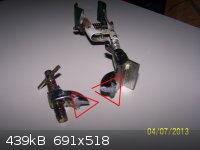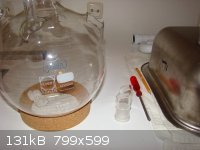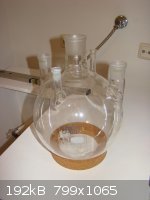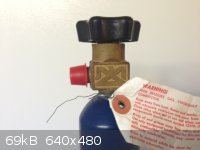| Pages:
1
..
16
17
18
19
20
..
38 |
froot
Hazard to Others
  
Posts: 347
Registered: 23-10-2003
Location: South Africa
Member Is Offline
Mood: refluxed
|
|
I've had a similar experience with a very similar looking cheap cast Zinc-like clamp. It appeared to me like it failed from chemical attack. As soon
as they have been exposed to corrosive fumes I would not dare use them for anything risky/expensive.
It might help to spray them with a coat of clear enamel to try prevent corrosion.
We salute the improvement of the human genome by honoring those who remove themselves from it.
Of necessity, this honor is generally bestowed posthumously. - www.darwinawards.com |
|
|
vmelkon
National Hazard
   
Posts: 669
Registered: 25-11-2011
Location: Canada
Member Is Offline
Mood: autoerotic asphyxiation
|
|
Here is a picture.
I tested with a rare earth magnet and it isn't magnetic. I know that this isn't a definite proof that it isn't steel.
The back screw is magnetic.
I'm thinking about making the part from lead.

[Edited on 4-7-2013 by vmelkon]
<!-- bfesser_edit_tag -->[<a href="u2u.php?action=send&username=bfesser">bfesser</a>: merging
threads]
[Edited on 7/8/13 by bfesser]
|
|
|
bfesser
Resident Wikipedian
    
Posts: 2114
Registered: 29-1-2008
Member Is Offline
Mood: No Mood
|
|
It's worth noting that high quality stainless steel (such as that used in good commercial kitchen equipment, or nice Swiss anti-magnetic tweezers)
won't significantly attract a rare earth magnet—I know this from personal experience. Still, that looks like zinc to me. I hate that
design of clamp (the one-piece type 'universal' type.) In my experience, nothing beats the three finger type with a solid boss-head. I have dozens
of clamps and boss-heads like those pictured:
<img src="http://orgchem.colorado.edu/Technique/Equipment/Images/Clamp3prong.jpg" />
The older clamps are better (corrosion isn't really a concern). Construction was more solid, they didn't skimp on alloys, and the machining was of
better quality. I also prefer the domestically produced ones (USA, in my case), not the cheap imported Chinese shite.
[Edited on 7/8/13 by bfesser]
|
|
|
mr.crow
National Hazard
   
Posts: 884
Registered: 9-9-2009
Location: Canada
Member Is Offline
Mood: 0xFF
|
|
Why are clamps such cheap metal? I broke a brand new one, but the liquid nitrogen probably helped! You could see all the crystal domains in the broken
metal.
Double, double toil and trouble; Fire burn, and caldron bubble
|
|
|
watson.fawkes
International Hazard
    
Posts: 2793
Registered: 16-8-2008
Member Is Offline
Mood: No Mood
|
|
Plenty of folks don't need high quality metal. If your business is, say, an
environmental testing lab, you're not going to be putting your gear under the same stress as in a research lab.
|
|
|
Organikum
resurrected
    
Posts: 2337
Registered: 12-10-2002
Location: Europe
Member Is Offline
Mood: frustrated
|
|
Quote: Originally posted by vmelkon  | Here is a picture.
I tested with a rare earth magnet and it isn't magnetic. I know that this isn't a definite proof that it isn't steel.
The back screw is magnetic.
I'm thinking about making the part from lead.
[Edited on 4-7-2013 by vmelkon] |
Naaa...
Just glue it with a good 2-component epoxy. It will not break where its glued, that being probably the strongest part then 
Had exactly the same problem twice. Glued. Holds perfect.
The material is high-pressure die casted zinc, whats a zinc alloy of some kind and truely cheap shit not worth a penny.
regards
/ORG
<!-- bfesser_edit_tag -->[<a href="u2u.php?action=send&username=bfesser">bfesser</a>: merging
threads]
[Edited on 7/8/13 by bfesser]
|
|
|
confused
Hazard to Others
  
Posts: 244
Registered: 17-3-2013
Location: Singapore
Member Is Offline
Mood: tired
|
|
i second the epoxy
|
|
|
Acidum
Harmless

Posts: 39
Registered: 2-5-2013
Location: Serbia
Member Is Offline
Mood: Sublimed
|
|
We had very similar problem at science/chemistry popularization show, when a young colleague of mine touched dewar filled with liquid nitrogen with
glass beaker filled with hot water from which he poured it gently to produce water vapour fog. Bunch of small kids were all around the table (many of
them leaning their heads on it), quite lot of fog emanating from dewar, and all the sudden BANG and entire table is engulfed in thick white fog! At
first nobody realized what happened, parents started to freak out, kids looking at us believing that this is all part of experiment, and when the mist
dissipated entire table was covered with glass shatters - and nobody got hurt!
...off course, we instantly removed young chemist from the table, cleared the mess, and put improvised fence meter from table...
...and then I disappeared in the mist...
|
|
|
bfesser
|
Threads Merged
7-7-2013 at 16:27 |
bfesser
|
Thread Pruned
7-7-2013 at 16:29 |
DutchChemistryBox
Hazard to Self
 
Posts: 74
Registered: 24-3-2013
Location: Strasbourg
Member Is Offline
Mood: No Mood
|
|
I had bought a three-neck 500ml rbf on a second hand sales site for 20 euro. Due to a miscommunication he thought that I wanted all his rbf's.
So I've also got a four-neck 1l rbf and a five-neck 6l rbf. Unfortunately 1 neck of the big flask broke during the shipping.
 
I think that I'm going to fix it with glue and use it as decoration. Maybe a glassblower can fix it so I can sell it.
[Edited on 8-8-2013 by DutchChemistryBox]
|
|
|
Lambda-Eyde
National Hazard
   
Posts: 860
Registered: 20-11-2008
Location: Norway
Member Is Offline
Mood: Cleaved
|
|
How much would you charge for the broken 6L flask?
This just in: 95,5 % of the world population lives outside the USA
Please drop by our IRC channel: #sciencemadness @ irc.efnet.org
|
|
|
prof_genius
Hazard to Others
  
Posts: 147
Registered: 15-5-2013
Member Is Offline
Mood: No Mood
|
|
Quote: Originally posted by DutchChemistryBox  | I had bought a three-neck 500ml rbf on a second hand sales site for 20 euro. Due to a miscommunication he thought that I wanted all his rbf's.
So I've also got a four-neck 1l rbf and a five-neck 6l rbf. Unfortunately 1 neck of the big flask broke during the shipping.
I think that I'm going to fix it with glue and use it as decoration. Maybe a glassblower can fix it so I can sell it.
[Edited on 8-8-2013 by DutchChemistryBox] |
What second hand site did you get it from?
[Edited on 8-8-2013 by prof_genius]
|
|
|
DutchChemistryBox
Hazard to Self
 
Posts: 74
Registered: 24-3-2013
Location: Strasbourg
Member Is Offline
Mood: No Mood
|
|
@Lambda-Eyde
If you are interested in it you can send me a U2U.
@prof_genius
I've got it from www.marktplaats.nl
According to the seller they're old rbf's of DSM
|
|
|
subsecret
Hazard to Others
  
Posts: 424
Registered: 8-6-2013
Location: NW SC, USA
Member Is Offline
Mood: Human Sadness - Julian Casablancas & the Voidz
|
|
I can't remember breaking anything in my lab... Though I once did spill some HCl on one of my clamps (Aluminium I think) and it still has spots of
AlCl3.
One time at school, some kid was playing with a steal ball which he proceeded to drop into a beaker on a hot plate. Luckily it was only being used as
a hot water bath...
On a separate occasion, someone stuck their head in a Bunsen burner, promptly loosing an eyebrow.
Don't ask me why...
Fear is what you get when caution wasn't enough.
|
|
|
Mailinmypocket
International Hazard
    
Posts: 1351
Registered: 12-5-2011
Member Is Offline
Mood: No Mood
|
|
A co-worker once decided to check how much gas was left in a lecture bottle by "opening it a bit to see" the thing is that it was a new cylinder and
had a red cap on the end. Thankfully it was only nitrogen, but the red cap flew off at such speed that it hit me on the cheek and made a red welt, I
could have gotten an eye injury. Stupid dummy... Doesn't work there anymore as far as I know. I wonder why. Who does a thing like that!?
Red cap like this:

|
|
|
phlogiston
International Hazard
    
Posts: 1379
Registered: 26-4-2008
Location: Neon Thorium Erbium Lanthanum Neodymium Sulphur
Member Is Offline
Mood: pyrophoric
|
|
A fellow student was refluxing a large volume (several liters) of a mixture of acetone and diethylether under reduced pressure when suddenly for
reasons that remain unexplained the roundbottom flask broke, spilling all of its contents in one big flood. Much of it gushed out of the fume hood
(there was only a small ridge) onto his legs. It was warm, but not so that it burned him painfully. However, this being the 90's and he being a lover
of hardcore house music, he was wearing synthetic pants and shoes typical for the subculture:

They were called 'gabber' in Dutch. To our amusement, his pants dissolved rapidly, leaving only a few mushy strips of fabric on his legs and a sticky
mess of what used to be his shoes. He walked around the rest of the day in his underwear, with a long labcoat over that. A friend went home to fetch
new clothes. Fortunately, no fires, no injuries and we all learned a lesson on safety.
[Edited on 20-8-2013 by phlogiston]
-----
"If a rocket goes up, who cares where it comes down, that's not my concern said Wernher von Braun" - Tom Lehrer |
|
|
elementcollector1
International Hazard
    
Posts: 2684
Registered: 28-12-2011
Location: The Known Universe
Member Is Offline
Mood: Molten
|
|
Broke 2 RBF's in as many days - this last one full of acetone! I managed to save some of it, but still...
I'm keeping the broken glass in case I need it for something (or figure out how to fix it), but do any of you do the same?
Elements Collected:52/87
Latest Acquired: Cl
Next in Line: Nd
|
|
|
Praxichys
International Hazard
    
Posts: 1063
Registered: 31-7-2013
Location: Detroit, Michigan, USA
Member Is Offline
Mood: Coprecipitated
|
|
I have had many mishaps over the years, some more notable than others.
The first one I can remember is the time I was in the second grade and I was already intersted in chemistry. I would bring small (~50mL) glass jam
jars full of "chemicals" (flour, water, vinegar, salt, etc.) to school in a large palstic bag my mother had generously provided for me, to be mixed on
the playground to amuse my friends. This ended one day as the bag touched the ground as I was swinging it rather carelessly in the hallway, causing
the jars to break and the CO2 evolved to inflate the bag, causing no small amount of alarm.... that practice ended quickly. Luckily, this was before
one was classified as a miniature domestic terrorist for such activities.
The second mishap I can remember is pouring about 25mL of mineral oil onto my first hotplate after having assumed "fog machine oil" I had previously
encountered was actually common mineral oil (erroneus, I later found out. It's glycerine.) Turns out it makes one heck of a lot of persistent white
smoke anyway, which proceeded to fill my parent's basement, much to their unamusement.
The third incident involves an attempt to melt moth balls in an effort to blend them into candle wax to make a candle that would (hopefully) kill
moths. Molten naphalene, as it happens (these were the days before p-dichlorobenzene was popular), has quite a vapor pressure. The house was evacuated
for a good hour to let things air out. However, every moth within a five mile radius must have died at this point. I think I was about 10 years of
age.
A fourth incident occured as I was melting lead and an old roll of solder in a beaker on my hot plate, as I had routinely done many times before.
Instead of casting it, I decided to make an ingot by letting it cool in the beaker. After cooling, it proved to be very difficult to remove from the
beaker. A few whacks to the overturned container freed the chunk of metal... and also the bottom of the beaker. Whoops.
In my first year of college, I had managed to find both concentrated sulfuric acid and ammonium nitrate at the local hardware store off campus. Having
always yearned for the coveted nitration mixture (and unfortunately having used organic peroxides before then) I decided to try making a small mixed
acid batch just to ascertain its properties and maybe nitrate a few cotton balls. This was in lieu of waiting a week to take it home the the lab
proper, which was still located in my parent's basement. I carefully cooled and mixed the two chemicals, and, noticing the peculiar fuming that
happens above such a mix in a humid environment, wafted some into my nose and took a breath. I nearly passed out. I distinctly remember the horrifying
and rapid onset of tunnel vision as I scrambled to put the glass somewhere where I would no longer be exposed to its fumes. I regained a shaky but
lucid composure rapidly and eneded up disposing of it in the bathtub with copious amunts of water. I had lots of fun with nitration reactions that
summer.
I also remember a time when I had melted a hundred or so grams of sodium hydroxide in a low, round food can. I was experimenting its extraordinarily
corrosive effects on various materials when I managed to get a drop of it on my forearm. I had a crater in my arm for a few months which has gradually
turned into a small red scar.
Before I moved out of my parents house I managed to burn the lawn many times with overzealous thermite experiments. The worst incident involved the
unforseen fallout from an ash cloud generated by a manganese-based thermite composition. This left the nearby concrete driveway leopard-spotted with
perminant tan stains of MnO2. My father was not pleased in the slightest.
Borosillicate microwave oven platters are a blessing and a curse. I have disassembled many, many goodwill-store microwaves for experiments, and I
often work over these glass plates to save my wooden benches from errant drops of sulfuric acid and other things which don't get along with plywood.
They are rather nice - unreactive, and can take a spill of about 250ml without overflowing. Unfortunately, though many beakers and flasks will survive
if dropped on plywood from a short distance, dropping them onto a heavy glass plate makes for almost certain breakage. I lost many pieces of my old
19/22 set in this manner. Luckily, I learned many lessons with the cheaper, smaller glassware before I sold the lot of it and upgraded to 24/40.
My latest mishap is not so bad, just a few polyacetal keck clips being reduced to a crumbly powder due to exposure to hot nitric acid vapor during a
routine liter-sized synth to replenish my stock of 68%. Luckily, they are cheap, and a lot of ebay sellers will throw them into a glass kit for free
in place of a glass stopper or two (of which I already have too many to be useful).
|
|
|
malford
Hazard to Others
  
Posts: 116
Registered: 17-6-2013
Member Is Offline
Mood: No Mood
|
|
Quick question: order these companies in quality (consistency of size, shape, thickness) and straightness -- Corning Pyrex, Wilmad-LabGlass,
Chemglass. Is there much of a difference?
|
|
|
Variscite
Hazard to Self
 
Posts: 69
Registered: 21-5-2013
Member Is Offline
Mood: diffusing
|
|
I know Chemglass is usually very thick, best suited for a mantle or some other slow heating method.
|
|
|
Dr.Bob
International Hazard
    
Posts: 2733
Registered: 26-1-2011
Location: USA - NC
Member Is Offline
Mood: No Mood
|
|
Quote: Originally posted by malford  | | Quick question: order these companies in quality (consistency of size, shape, thickness) and straightness -- Corning Pyrex, Wilmad-LabGlass,
Chemglass. Is there much of a difference? |
Pyrex is still good stuff, but they are not as easy to find anymore, or as consistant. Much of their stuff is now made in Europe, so it costs more
than others in some cases. ChemGlass seems to be the best now, with a good online catalog, and LabGlass is also good, and Kimble/Kontes is also
still OK. Another one I still like is Ace, they have a good online catalog as well, which is very helpful given how complex some of the glassware is.
The Chemglass thick-walled flasks are the heaviest walls of any glassware I have ever seen, great for sturdiness, bad for heating harshly, as they
will crack from heat stress if abused.
|
|
|
prof_genius
Hazard to Others
  
Posts: 147
Registered: 15-5-2013
Member Is Offline
Mood: No Mood
|
|
I remember once i was showing off my lab glass and dropped a 250ml beaker. 
|
|
|
Plutonium239
Harmless

Posts: 10
Registered: 2-9-2013
Location: South Carolina
Member Is Offline
Mood: No Mood
|
|
Yesterday I mixed some sodium hypochlorite and muriatic acid in an antique volumetric flask. So much gas was produced that the glass stopper was
blown off and hit the wall, but everything was OK. I guess I should have done some stoichiometry.
|
|
|
MichiganMadScientist
Hazard to Self
 
Posts: 55
Registered: 22-7-2013
Member Is Offline
Mood: No Mood
|
|
Quote: Originally posted by Plutonium239  | | Yesterday I mixed some sodium hypochlorite and muriatic acid in an antique volumetric flask. So much gas was produced that the glass stopper was
blown off and hit the wall, but everything was OK. I guess I should have done some stoichiometry. |
Just curious: What exactly were you trying to accomplish by doing this? 
As for me, my worst lab accident was when I had a rather large HDPE bottle containing conc. HNO3 leak out. I had stored the bottle inside a rubbermade
tub full of various equipment, which promptly rusted from the fumes.
But here's the crazy part: I also had assorted glassware in that same rubbermade tub. I had wrapped the glassware in a bunch of old cloth rags/tshirts
to preventage breakage. The fumes were so crazy they literally reduced the rags to shreds of powdery fabric...
[Edited on 5-9-2013 by MichiganMadScientist]
|
|
|
Metacelsus
International Hazard
    
Posts: 2539
Registered: 26-12-2012
Location: Boston, MA
Member Is Offline
Mood: Double, double, toil and trouble
|
|
The same thing happened to me when I was working with aqua regia. I picked up a rag that I had nearby, and it just disintegrated.
|
|
|
12AX7
Post Harlot
    
Posts: 4803
Registered: 8-3-2005
Location: oscillating
Member Is Offline
Mood: informative
|
|
Lucky those rags didn't also catch fire!
I've had sulfuric acid residue decompose rags (paper towel rags, to be exact). Example: filtering crystals away from acidic supernatant. Crystals
are rinsed and dried; rags are rinsed several times and allowed to dry (reduce, reuse, recycle!). After weeks, the rags range from weak to crumbling.
This is, of course, something sulfuric acid is very good at.
Tim
|
|
|
| Pages:
1
..
16
17
18
19
20
..
38 |